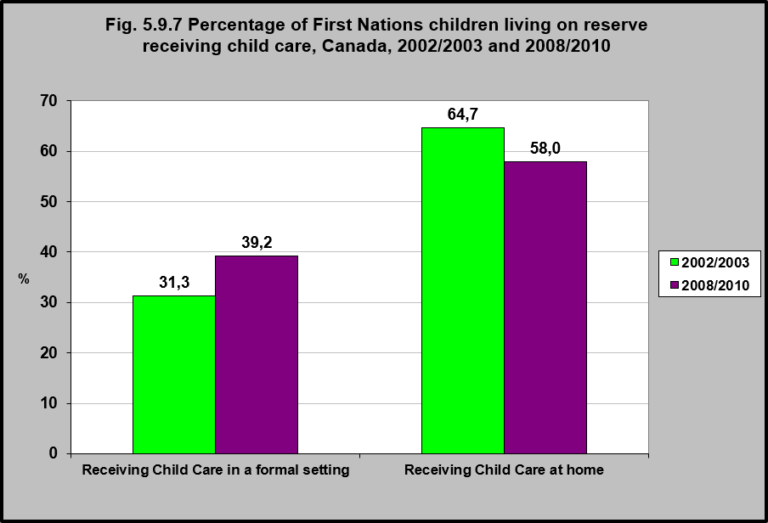Percentage of First Nations children living on reserve receiving child care, Canada, 2002/2003 and 2008/2010

Source: CICH graphic created using data adapted from the First Nations Regional Longitudinal Health Survey (RHS) 2008/10, National report on adults, youth and children living in First Nations Communities. https://fnigc.ca/sites/default/files/docs/first_nations_regional_health_survey_rhs_2008-10_-_national_report.pdf -accessed July 19, 2017.
In 2002/2003, 31.3% of First Nations children on reserve received child care in a formal setting. This increased to 39.2% in 2008/2010.
In 2013/2015, 40.9% of First Nations children on reserve received child care in a formal setting.1
Of the First Nations children on reserve receiving care, a greater proportion of children received care in home settings, however this is decreasing. In 2002/2003 it was 64.7% and in 2008/2010 it was 58%.
1First Nations Information Governance Centre, Our Data, Our Stories, Our Future: The National Report of the First Nations Regional Early Childhood, Education and Employment Survey. 2016. http://fnigc.ca/sites/default/files/docs/fnigc_fnreees_national_report_2016_en_final_28072016_0.pdf-accessed August 25, 2017.
Implications
Since 2002, there has been a decline in the proportion of First Nations children living on reserve who are participating in formal child care programs or receiving child care at home, and an increase in the proportion who are receiving child care in an informal setting. Informal settings are less likely to provide quality learning experiences that enhance cognitive development and language acquisition for First Nations children. There is a considerable difference in quality between formal and informal care; children in informal care settings watch more television per day, and spend less time on reading and math activities, with corresponding differences in learning.3 There are a variety of reasons why parents choose informal care settings for their young children, including limited information about quality, the need for flexible arrangements, cost, and limited access to formal care settings.2
2Loeb, S. (2016). Missing the target: We need to focus on informal care rather than preschool. Evidence Speaks Reports, 1(19). Retrieved October 12, 2017 from https://www.brookings.edu/wp-content/uploads/2016/07/childcare2.pdf
